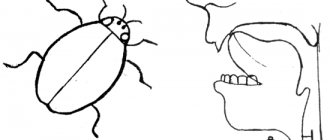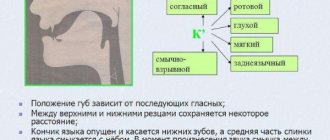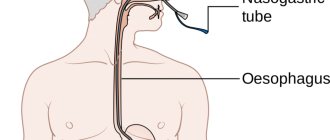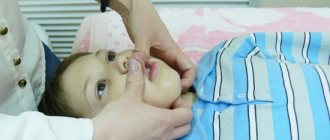The sound C belongs to the whistling group, but its articulation is more complex than that of S and Z. Correction begins after establishing the correct pronunciation of other whistlers. Because the desired articulatory structure will be formed, which is the basis for sound production.
Phoneme C, like other sibilants, appears early, and if at the age of three the child has not mastered correct pronunciation, contact a speech therapist or start practicing on your own.
The sound C is the most complex of the whistling group, because it combines C and T. Its production may require more careful preparation if there is distortion of C or T. Correctly composed tasks for correcting sound pronunciation will help make the child’s speech beautiful and literate.
Features of articulation
Normally, when pronouncing C, the lips are in the position of a slight smile, the teeth are visible. They are slightly closer together, there should be a small gap between them. The tip of the tongue should be made wide and placed in the lower oral cavity. And its side edges touch the upper teeth.
Feature of the articulation of the sound C - the front part of the tongue should take a position for several seconds as for pronouncing T. In this position, together with the alveoli, the tongue forms a gap, and when exhaling, the stream turns out to be strong, cold, as when pronouncing S. Pay the child’s attention to the peculiarity of the exhaled stream: it not just directional, but jerk-like. When pronouncing this phoneme, a person pushes out air. The vocal cords are open and do not work, so the sound C is a dull consonant.
Characteristics and articulation of the phoneme C
Explain to your child the structure of sound, qualitative characteristics (voiced or voiceless, paired or unpaired), as well as the nature of the formation of letters by the speech apparatus, so that it is easier for him to understand how a phoneme is formed. “C” is an unpaired dull sound. It has no counterpart in softness and is always hard. It is not softened by the vowel sound that comes after it (circus [tsyrk] or number [tsyfra]).
Important! You should tell your child about sound after he or she reaches a certain age ( grades 1-3 ).
Classes for preschoolers (5-6 years old) are best conducted in a playful way, without overloading the child with terms and concepts.
Articulation profile “C”:
Don't miss: The simplest and most effective ways to make the sound R and Rb
Description of the articulation of the sound “C”:
- Tongue position:
- the tip focuses forward on the lower teeth;
- the organ is raised and arched like a mountain;
- the back closes with the sky;
- the sides become tense;
When the air stream comes out, quickly move the front part of the tongue away from the palate. We pull its tip slightly away from the lower incisors. This increases the push of air at the outlet.
2. Keep your lips smiling.
3. The incisors are closed or as close as possible (in isolated reproduction).
4. Vocal folds are relaxed. There is no vibration.
When playing the phoneme “C”, the air stream should be strong, explosive as you exhale. This characteristic is characteristic of the phoneme “T”. The letter “C” gives a whistling connotation. But the correct pronunciation of “S” and “T” does not mean that there are no problems with the sound “C”.
Types and mechanisms of violations
Incorrect pronunciation of a whistling group is called sigmatism, and replacement in speech with other sounds is called parasigmatism. Sigmatisms differ in the mechanisms of the disorder. The reasons are the structural features of the organs of the articulatory apparatus.
These include:
- malocclusion;
- weak or increased muscle tone of the tongue;
- cleft lip, palate.
The listed anatomical features lead to disruption of articulatory motor skills, which is one of the reasons for incorrect pronunciation. The most common reason is incorrect tongue position. If it is located between the teeth, then speech will be lisping. He may take a position to pronounce T or S, then the phoneme will sound unclear.
The tongue may move to the side and the air stream will not pass through the center, but through its side edge, resulting in a “squelching” effect. Or it may rise strongly towards the sky, causing the air stream to escape through the nose and speech to sound nasal. The articulation may be similar to the articulation of sibilants, and C will sound like F.
Sigmatisms are also signs of the following speech disorders:
- dyslalia;
- dysarthria;
- rhinolalia;
- alalia.
In addition, the reasons for sound distortion can be social:
- When communicating with a child, adults distort speech, resulting in the so-called lisp. Such communication can be maintained until the child begins to speak. He must hear the correct pronunciation of sounds so that later his speech will be literate.
- The child communicates with adults or children who have difficulties with sound pronunciation and imitates their speech. It is necessary that these people begin to correct their speech, or try not to use words that have a “difficult” sound. Especially if you are already going through the automation stage.
Most often, C is replaced with other sibilants or with T. This is due to the fact that it combines two sounds, so if a child’s phonemic processes are not sufficiently developed, then he may not be able to distinguish the desired phoneme from others due to similar acoustic and articulatory features. And this is also due to incorrect pronunciation. Corrective work depends on the cause of the appearance of sigmatisms and parasigmatisms.
"Sound T"
How to pronounce the sound Ts normally.
The sound Ts (in Russian transcription [ts]) is a consonant, deaf, hard. It is formed by merging the sounds [t] and [s] into a single sound. There are no sounds equivalent to it in terms of sonority and softness in the Russian language.
When pronouncing the sound [ts], the organs of articulation occupy the following position:
- the lips are slightly stretched in a smile, so that the upper and lower incisors are exposed;
- the teeth are brought together, forming a gap of 1-2 mm;
- the tip of the tongue is wide, located in the lower part of the lower front teeth;
- the lateral edges of the tongue are raised and tightly meet the upper lateral teeth;
- the back of the tongue in its front part closes tightly with the upper alveoli for a split second, as when pronouncing [t], after which it forms a narrow gap with them (v. alveoli) for the exit of a stream of air, as when pronouncing [s];
- the air stream is strong, jerky, passes through the middle of the tongue and when you bring the back of your hand to your mouth it feels cold;
- the soft palate is pressed tightly against the back wall of the pharynx, preventing air from escaping into the nose;
- vocal cords are open and do not form a voice.
Sound production methods
Method of setting
NO SOUND:
By imitation:
a) Tactile sensation: bring the back of the child’s hand to the speech therapist’s mouth, so that when the sound [ts] is quickly pronounced, he feels the blow of an air stream.
b) Do the exercises: “Fence” - “Window” “Bridge”. Place the tip of your tongue against your lower front teeth. The back of the tongue is arched and touches the upper front teeth. In order for the back of the tongue to better contact the palate, the lateral edges of the tongue are clamped with the teeth and remain clamped at the moment of inhalation and at the moment of exhalation, the tip of the tongue is free. After inhaling, exhale the air with a short strong push while simultaneously lifting the tip of the tongue from the lower front teeth. A stream of air passes through the middle of the tongue, the position of the teeth does not change, the lips are tense and stretched in a smile, i.e. the “Fence” position. A short sound [ts] is heard - “Grasshopper.”
c) The same, but without pinching the lateral edges of the tongue.
[Ts] – titmouse song, “Quiet, the children are noisy”
Let's try to make the sound [C] by imitation. Sit in front of the mirror. Take your baby's hand and bring it to your mouth. Say exaggeratedly with a strong exhalation: “Ts-ts-ts - …”. The child should feel the blows of cold air on his palm. Pay attention to the baby's correct position of the tongue and lips (they are slightly open in a smile). Let him copy all your actions and repeat: “Tsk-tsk-tsk -...”. It may take several repetitions or classes to get it right. Strengthen the result by repeating the syllables: tsa-tsa-tsa, tso-tso-tso, tsu-tsu-tsu, tsy-tsy-tsy, tset-tse-tse. When pronouncing these straight syllables, the lips must take the position of the following vowel sound. At the first stage, the pronunciation is still exaggerated and tense. But gradually everything will fall into place, and articulation will become effortless.
The child is offered a sample of sound pronunciation in combination with play images (a horse clicks its hooves, a girl asks not to make noise, etc.); At the same time, visual control of correct articulation and tactile (tactile) sensations are used.
From reference sound:
a) From the “Bridge” position, say in a row: “tss”, “tss”, “tss”, speeding up the tempo: “tss”, “tss”, “ts”.
b) From the “Shovel” position, bite the front part of the tongue in the syllable: “at” and blow, you get “at-s = ats”.
Mixed method:
Complete the exercises: “Fence” - “Window” “Bridge”. In the “Bridge” - “Fence” position, hold your tongue with a spatula, pronounce the sound [t] - biting the front part of the tongue with your teeth, and then pronounce [s]. At first these sounds are pronounced separately, and then together.
Note: when performing the sound [ts], the child is not called, but is replaced with the name of the exercise “Grasshopper”.
Since the position of the organs of articulation of the sounds “S” and “Ts” is very similar, the sound “Ts” is quite easily placed on the basis of the correctly pronounced sound “S”, but requires additional work with the tip of the tongue, since its movements when pronouncing all the mentioned sounds are very similar. Therefore, it is important to explain to the child the principle of operation of the tip of the tongue when pronouncing each individual letter, for greater clarity, resorting to comparing them.
As soon as the child begins to correctly pronounce the isolated sound “C”, it is necessary to immediately begin to automate it.
Setting [C] is possible only after the sound [s] has been corrected and entered into the child’s speech. Place [ts] from [t] with the tip of the tongue lowered to the lower incisors and the front part of the back of the tongue pressed against the upper incisors. The child is asked to pronounce [t] with a strong exhalation. At the same time, they pronounce [t] and [s] sequentially. To get a merged sound with a shortened whistling element, the child is asked to pronounce the reverse syllable with the vowel [a] (ats). When it is difficult to hold the tongue against the lower incisors, mechanical assistance is provided. Using probe No. 2, the speech therapist holds the tip of the tongue against the lower incisors and asks to pronounce [ta] with a strong exhalation (at the moment of exhalation, lightly press the tongue = [ts]).
With this sound, the teeth are exposed in a “smile”, brought together or closed. A stream of air goes simultaneously to the tip of the tongue and the front teeth. The tip of the tongue, resting against the lower teeth, rises sharply with its back to the sky and also sharply descends. The air stream is interrupted: a bow occurs. The air stream is jerkily applied to the front teeth. This can be felt on the back of your hand. The air stream is cold and rubs against the front teeth.
Now we try with the child to imitate the “burst” balloon: “T-ssss.” The sound “Ts” consists of two: “T” plus “S”. If the child pronounces these sounds correctly and easily, then this will not cause any difficulties. It is imperative to watch your “smile” - expose both the upper and lower teeth. The tip rests on the lower teeth. We teach the child to bow quickly. You can use the term “shoot”-ts-ts. The “S” sound does not last in this case. Like “T,” it is pronounced abruptly. But when our ball “bursts”, in this case we can pull “C”. This is done so that the child can better feel the flow of air and the sound itself.
It must be remembered that sometimes you can get the sound “S” from “C” when pronouncing it for a long time: C = T + Sssssss and we fix it separately.
When the child pronounces the sound “C” clearly and in isolation, we begin to automate it. If it doesn’t work out, then continue to imitate while playing.
When the child correctly pronounces the sound “C” in isolation, we begin to automate it.
It is better to automate this sound in words in which it is at the end.
We come up with sentences with these words.
We teach proverbs, riddles, and poems with the child.
From articulatory structure:
The child is asked to reproduce the articulatory pattern of sound, apply the correct air stream, and determine the presence/absence of a voice; the result should be a normalized sound.
11. Setting the sound [Ts] from art. "Reel" style
Invite the child to open his mouth, rest the tip of his tongue against the lower front incisors, and lift and bend the tongue so that the front part is pressed against the palate. The tongue touches the upper incisors with the back. Without turning on the voice, pronounce a sound that imitates the sound [T]. The sound is pronounced at the moment of opening, when the tip of the tongue bounces off the lower front teeth under the pressure of a strong air stream of exhaled air. The lips are tense and stretched into a smile. Definitely control with the palm of your hand.
Setting the sound [Ts] from the telephone exchange
The sound [C] is better placed in reverse syllables. The child is asked to pronounce the sound [T] with maximum exhalation. At the same time, the sounds [T] and [S] are pronounced sequentially. In this case, the sound [S] must be pronounced drawn out. Then the sound [A] is turned on, and the child is asked to pronounce the combination [ATS] with a strong exhalation at the moment of transition from [A] to [TS].
LABIODENTAL Sigmaticism
This time it is the lower lip that is showing disobedience. It is necessary to remove the labial articulation. This may be possible using your index finger. Use it to press the baby's lower lip to the base of the lower teeth (the finger should be placed horizontally). Hold your whim while the child pronounces forward and backward syllables with the sound [C]. After some time, your help will no longer be needed.
There is another way to combat this sigmatism. The baby shows a dazzling smile (the upper and lower teeth are visible). You fix the corners of your mouth with your thumb and forefinger: you need to keep that Hollywood glow for as long as possible! Without changing the position of his lips, the child, following you, pronounces the syllables: tsa-tsa-tsa, tsy-tsy-tsy, tset-tse-tse, ats-ats-ats, its-its-its, ts-ts-ts. As soon as the lower lip learns to behave decently, and the sound [Ts] sounds clearly, the “supports” are removed.
Speech diagnostics
To determine the cause of the violation of sound pronunciation, it is necessary to make a diagnosis of speech development. The speech therapist begins his work by examining the articulatory apparatus: appearance, motor skills. To do this, he asks the child to perform exercises to maintain the desired posture - in the case of a whistling group of sounds, they practice the lower position of the tongue, holding it behind the teeth, and dynamic tasks that help assess the mobility of the lips and tongue. First, the speech therapist shows the exercise, then asks the child to repeat it.
Speech therapy diagnostics includes tasks to assess speech breathing. The specialist pays attention to how the child inhales and exhales, and whether his diaphragm is working. To assess the force of exhalation, you can offer to blow away a light object or play the pipe.
Speech material must be selected not only from C, but also from C and T, because production of a given sound can only begin if the child pronounces the reference phonemes correctly.
The child repeats all tasks for naming syllables and words after the adult. It's the same with phrases and sentences. All instructions must be clear and the adult's pronunciation must be clear.
And in tasks for coherent speech, the speech therapist asks the child to compose a short story based on the picture or tell something about a subject that is close to him. You need to select the material so that one word and sentence does not contain C, S and T at once.
Then the child is offered tasks to identify the desired sound among others. Then the speech therapist shows him pictures and asks him to name words that contain C. Before completing the sound analysis task, the adult explains to the child what the beginning of a word, the middle and the end are. Then he says a word and asks to determine where the sound is.
In addition to speech diagnostics, the speech therapist must communicate with parents. This is necessary not only to advise them on all important issues and explain the corrective work plan. So the specialist will also determine in what speech environment the child is being brought up and whether it is necessary to carry out work in this direction.
SPEECH DEVELOPMENT AND PARENTAL INVOLVEMENT
So what is parental help? First of all, it is important for adults to understand that it is impossible to simply teach a child to say letters. This process is long, systematic and comprehensive. Children’s speech develops along with the improvement of other skills: both psychomotor and physical. If the baby is behind in development (he started holding his head up late, sitting up, he has problems with memory, attention) - speech will most likely also lag behind.
What needs to be done to ensure that everything happens on time? Firstly, monitor overall development - train muscles, dexterity, motor skills, memory, attention.
The following aspects are especially important for developing speech skills.
- From a very early age, parents should speak to the child clearly and correctly: without childish touching “lisping”, without adjusting words to the child’s age. Yes, a baby can speak incorrectly due to age-related imperfections of his speech apparatus. But he should hear only accurate speech around him: correct, clear, literate, without verbal garbage (“well this”, “damn”, “in short”, “what”), otherwise the incorrect pronunciation will become fixed in his speech and then these problems will arise adjust with specialists. And this is much more difficult.
- The process cannot be left to chance. With such a passive approach, the baby will certainly begin to lag behind. Teaching him the correct pronunciation is just as important as teaching him to hold a spoon or pull on tights.
- There should always be an active speech environment around the child. He must hear speech all the time. You need to comment on all actions, talk about everything that is happening, and name all the surrounding objects. Then the child from an early age will not only enrich his passive vocabulary, but also understand the importance of speech for communication.
Exercises to develop articulatory motor skills and speech breathing
Before staging the sound, it is necessary to prepare the organs of articulation to form the desired structure by doing gymnastics. They need to be selected taking into account the pronunciation of reference sounds. In the case of C, these are T, S. But the exercises for developing the correct structure for these phonemes are almost the same as for C. If it is difficult for a child to keep his lips in a smiling position, then you need to practice this position.
You also need to normalize the muscle tone of the tongue; for this, purchase a set for speech therapy massage.
The child can spank it with his lips and lightly bite it. All exercises for the tongue should develop the ability to keep it down, and it should be wide and relaxed. Ask your baby to make his tongue look like a hill and fix it in this position.
In addition to tasks on maintaining a certain position, include tasks on dynamics in the complex. These are movements of the tongue up and down, to the sides, offer to brush their teeth and lick their lips. But in all exercises you need to train the lower position of the tongue in order to form the correct basis for the pronunciation of sibilants.
If a child has nasal sigmatism, then the complex of preparatory work must include tasks for the formation of correct speech breathing and a strong air stream. You can first learn to inhale through your nose and exhale through your mouth while lying down. Be sure to focus on the work of the diaphragm, place the child’s hand on this area.
To practice strong exhalation, invite your child to play the pipe or play the game “Who will blow out the cotton wool or feather next.” You can perform breathing exercises by placing your wide tongue on your lower lip, so you will not only train the force of exhalation, but also the lower position of the tongue.
Articulation complex exercises
At home or in kindergarten, but it is better to start with the following set of exercises:
- We make a long tube with our lips, try to pull it out as far as possible, and hold it for as long as possible. We make sure that only one lips are working.
- We stretch our mouth into a smile. With this exercise, the teeth are clearly visible and the lips are stretched as much as possible. We keep smiling until our lips become tired.
- We make a ring from the lips and again hold them in this tense state.
- We alternate this chain: tube - ring - smile - tube - ring - smile and so on.
- In the smile position, open and close your mouth. It is important that the lips do not make any extraneous movements.
- We stick our tongue out of the slightly open mouth and ensure that the tongue becomes flat.
- The same exercise, but we achieve a sharp and narrow shape of the tongue.
- We combine the previous two exercises and force the tongue to alternately take a wide and narrow shape. We alternate actions.
- Raise your tongue and hide it behind your upper teeth.
- We alternately raise the tongue to the upper palate and lower it to the lower palate. We repeat many times.
- Press the tip of the tongue against the lower palate near the teeth and make the tongue “stagger”, either going deeper into the mouth or approaching the teeth.
We check if the baby easily performs articulatory exercises, then move on to sound production complexes. And if the baby has a very difficult time performing these movements, then we only train them for now before learning the sounds.
How to set sound
You can set the correct sound yourself at home; in speech therapy there are different ways of setting it. But before you or a speech therapist begin working on correction, the child must correctly pronounce S and T. If the baby speaks one of these sounds incorrectly, then it is necessary to correct their pronunciation, and then begin to pronounce C.
Exercises:
- By onomatopoeia. The child pronounces the combination TS, gradually accelerating the tempo, resulting in C.
- Using a reference sound. You can choose to pronounce S or T. While pronouncing T or S, the adult asks you to move your tongue a little further away from your teeth. Gradually the child will be able to pronounce the correct sound.
- Mechanical approach. To do this you will need a spatula or probe. If the support is on T, then use the tool to place the tip of your tongue behind your lower teeth. If the support is on C, press the tip of your tongue deep into your mouth. You should get C.
- From the reverse syllable - ATS. The child should pronounce it in one exhalation. It turns out a clear C.
- If a child has interdental sigmatism, ask him to bite on a cotton swab, and with its tip, gently push the tongue further inward, lightly pressing on the back. Ask him to pronounce TS, and you will get a fuzzy T. Gradually, when pronouncing, he will learn to say it without mechanical assistance.
If you use the method of setting from a reference sound, then C may have a slight overtone of Ch. When the child learns articulation, the whistling sound will be clear. If there are no major deviations in the functioning of the articulatory apparatus, then with the help of onomatopoeia and a reverse syllable you can quickly create the desired sound. How many production sessions you need will depend on the speech disorder and the individual characteristics of the child. You can move on to the sound automation stage after your baby begins to pronounce an isolated sound clearly.
A set of exercises for clear pronunciation of the sounds C, Z, S
Before performing the exercise, tell your child in words how the tongue should move, and watch how the baby performs them. Kids won't be upset by the mistakes they make if you treat them with humor. A common mistake can be puffing out your cheeks. Let the baby hold his cheeks with his hands so that they do not puff up.
Goal!
The first important skill when producing the C sound is to learn how to reproduce a long, continuous stream of air. Place two elements of the construction set or cube on the table - these will be the gates. Place a cotton ball in front of them. The baby must stretch out his lips, fold them into a tube and use a stream of air to push the ball into the goal. Cheeks should not puff up! The air supply occurs not through the cheeks, but from the lungs.
The tongue lay down to rest
We open our mouth slightly and, with the help of lightly patting our lips, say “five five five five.” Now we show a relaxed, flat, wide tongue from the mouth and place it on the upper lip. We do “five five five five” directly along the back of the tongue - this is a massage for the resting tongue. Each pat of the tongue with the lips should be done with one exhalation.
Pancake tongue
Teach your child to hold his tongue in a relaxed position and stick out for as long as possible. It is important that your lips should not tense or curl up. The sides of the tongue should touch the corners of the mouth - a wide tongue.
Clean teeth
Use the tip of your tongue to “clean” all the teeth in your mouth. Pay attention to both the “backs” of the cloves and their outer surface. This exercise is especially important when it is necessary to produce the sound C. Make sure that your lips are motionless during the exercise and stretched in a calm smile.
Automation recommendations
The goal of this stage is to consolidate correct pronunciation in ordinary speech. Many parents believe that if a speech therapist sets a sound, the child will immediately speak it correctly without the help of adults and without errors in speech. But in order for the baby to begin to use the phoneme without errors, the organs of articulation must remember the desired position when pronouncing. Therefore, any sound must be consolidated in stages.
You need to start working with simple speech material - this is an isolated pronunciation.
The adult explains to the child the features of articulation, focusing on the position of the speech organs involved in the formation of the phoneme. Therefore, at the beginning of this stage, be sure to pronounce the sounds together.
Then work with syllabic paths, phrases, nursery rhymes. At the beginning, the speech material is saturated with the sound being practiced. This is necessary to automate the correct articulation pattern. The baby will hear the correct pronunciation of the phoneme being practiced.
To introduce C into independent speech, suggest composing phrases and sentences with certain words (heron, egg, chain). You need to learn to tell stories from a picture. At the automation stage, do not include words with other sibilants and the T sound in your speech material, so as not to complicate the automation process. Include the correlation of sounds and letters in your lessons, your child will more easily learn writing and reading at school.
Ts – cheerful sound and friend!
The sound C is related in articulation to Z and S. And the sound C consists of two sounds - T and S. Therefore, when pronouncing it, we must teach the child to correctly reproduce both of these sounds at the beginning.
When pronouncing C, the air wave is quite strong. Usually C is given to children simply, since it is based on the pronunciation of previously learned C. You can automate the sound using special verses, which a specialist will suggest to you.
Working on making sounds for babies is an exciting and fun process. Do not try to teach the child, it is better to play with him, then the result will be much more productive.
Video with articulatory gymnastics for clear pronunciation of whistling sounds (s, z, z):
What to do at the differentiation stage
At the differentiation stage, correction of parasigmatisms is carried out. The speech therapist or parents offer tasks for phonemic processes. An adult must pronounce sounds clearly and emphasize them strongly with his voice. This is due to the fact that if the child pronounced the mixed sound incorrectly, then he heard the phoneme distorted.
If it is difficult for him to identify the desired phoneme by ear, offer to repeat it after an adult. Gradually, the baby will learn to complete the task by ear. Offer to find a phoneme in syllables and words. Pay attention to articulation, especially if you rely on pronunciation when performing exercises.
Work on the sound analysis of the word. Explain to your child where the beginning, middle and end of the word are, what sounds are called consonants and vowels. Be sure to characterize C, practice identifying the place of the phoneme in syllables. Then start working with words.
Invite your child to divide the pictures into groups with certain phonemes. First choose phonemes that are completely different in acoustic and articulatory characteristics. Then, when you reinforce the correct pronunciation of words, include phonemes from the same group (C and C) in your lessons.
Carry out correction work gradually; there is no need to burden the baby with a lot of information. It is step-by-step that is an important component of successful training.
Duration and tips for organizing correctional work
The duration of therapy depends on the speech disorder and how parents responsibly approach speech therapy sessions. Their number should be at least 3-4 times a week. Their duration depends on the age of the child. Be sure to use visual material.
It's okay if automation takes longer in syllables and words. Often, consolidation in coherent speech occurs faster because the child has mastered correct articulation. But you only need to automate clear sound without distortion.
For correctional work to be effective, you may need the help of other specialists, especially if the child has a complex speech disorder. This is a defectologist, a neurologist, because in this case it is necessary to provide a complex impact.










